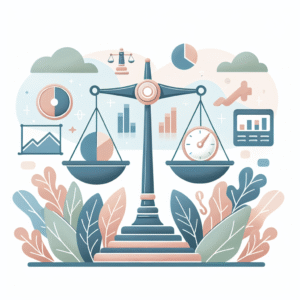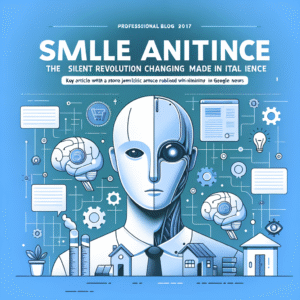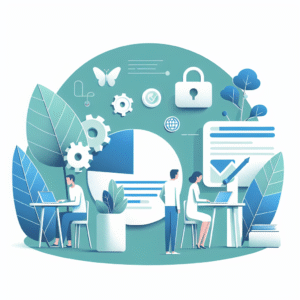By now the topic is dominant in the news and talk shows; everyone hears about it several times a day, but the writer puts himself in the shoes of those who, for professional reasons, have always lived a thousand miles away from this sector that, for us insiders, has represented for many years a utopia that has now come true.
The topic is certainly not drinkable in two minutes, like when you had to give someone the recipe for carbonara, but let's try anyway.
Let's start by clarifying what Artificial Intelligence is not: it is not a great electronic brain, nor a mechanical one; it is not a monster in human form that spits out sentences against us poor beings of flesh and blood, nor does it wait perfidiously around the corner to trip us up and take power over the world in our place.
It is not an abstract entity, other than us, and eager to acquire sufficient autonomy to make all decisions on our behalf.
We will always be able to turn off the power, mechanically, if we want, thanks to the existence of manual switches, shears, axes and bulldozers capable of cutting the power cables. And this should make us all more at ease.
We are ready to define, instead, Artificial Intelligence for what it is: a software; a linguistic model (O LLM – Large Language Model), capable of processing with unprecedented speed the information present on the network to respond to our questions and our needs in real time.
It does not invent anything and does not destroy anything, but re-elaborates what Man has already put into the network in order to package the response that we need at that moment.
Imagine finding yourself in front of a library employee whom you can ask not to retrieve a book for you, but to consult all the books you need to put together a research project, say, on the Sumerian Ziggurats.
And imagine that this good man, as soon as you ask him, starts looking for all the necessary texts at such a speed that you can't see him, and then starts writing a three-thousand-word research paper on the table and delivers it to you... in three or four seconds at most.
You will ask him, “How much do I owe you?”
He will answer you “Nothing, the service is free” and you will be amazed by the fact that, after all that running, he hasn’t even shed a drop of sweat.
Here is the Artificial Intelligence of 2024 explained to the People.
Artificial Intelligence (AI) is a constantly evolving field that has seen significant developments in recent years.
In 2020, OpenAI released the GPT-3 natural language processing model, capable of producing text modeled after the way people speak and write.
In 2021, the European Union Parliament proposed a regulatory framework to ensure that AI systems deployed in the EU are “safe, transparent, traceable, non-discriminatory and environmentally sustainable”.
OpenAI then developed DALL-E, a system capable of creating images from text prompts.

Image I got by asking Bing Image Creator to imagine a Juve Inter played in St. Peter's Square
Generative AI tools, sometimes called chatbots, such as ChatGPT, Gemini, Claude, and Grok, use artificial intelligence to produce written content in a variety of formats, from full-blown essays on topics across disciplines, to computer code, to answers delivered based on simple questions.
Generative AI has gained huge popularity in recent years, especially with chatbots like ChatGPT and Gemini, along with image generators like DALL-E 2 and Midjourney.
These tools are often used to create written copy, computer code, digital art, object design, and more. They are used in industries such as entertainment, marketing, consumer goods, and industrial manufacturing.
Looking ahead, one of the next big steps for AI will be to move beyond the weak AI, or narrow AI as we know it today, that is, generated from mere language models, and toward artificial general intelligence (AGI).
With AGI, machines will be able to think, learn, and act in the same way as humans, blurring the line between organic and artificial intelligence.
This could pave the way for increased automation and problem-solving capabilities in medicine, transportation, and more – as well as AI that is sentient, capable of making informed decisions, almost acquiring its own form of wisdom based on trillions of statistical data.
When we talk about Artificial Intelligence we are not talking about a new topic: it is a rich history, dating back to the 60s, with the ALPAC report of the United States government that highlighted the lack of progress in research on machine translation.
In the 1970s, the first successful systems such as DENDRAL and MYCIN were created at Stanford.
In 2020, GPT-3 was released by OpenAI.
Artificial intelligence technology continues to evolve rapidly with new discoveries and applications that impact different sectors of society.
It is a tacky mistake, therefore, to relegate it to the status of an extravagant and dangerous technological game with an almost playful flavor, as a certain vulgate that is very widespread on social media today would have it: if one day we will be able to prevent diseases that today lead many human beings to the grave because they are not detected in time; if one day a plane that finds itself in difficulty at high altitude will be able to land avoiding disaster; if one day we will have a home automation system that, while we are at work, will be able to prepare a nutritionally healthy dinner for us, avoiding us having to resort to last-minute solutions such as gorging ourselves on pizza or "solving" with two sandwiches and a beer, we will owe it to an Artificial Intelligence at our service, and in our total control.







